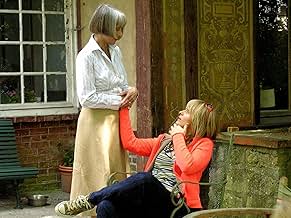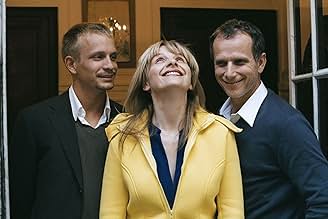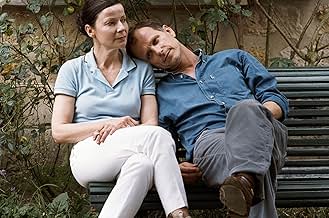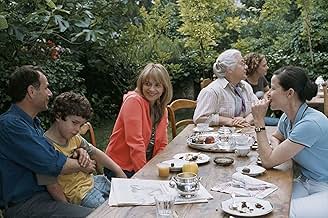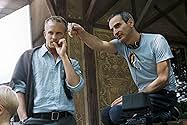PUNTUACIÓN EN IMDb
7,1/10
8,3 mil
TU PUNTUACIÓN
Dos hermanos y una hermana presencian la desaparición de sus recuerdos de infancia cuando deben ceder los bienes familiares para asegurar la sucesión de su madre fallecida.Dos hermanos y una hermana presencian la desaparición de sus recuerdos de infancia cuando deben ceder los bienes familiares para asegurar la sucesión de su madre fallecida.Dos hermanos y una hermana presencian la desaparición de sus recuerdos de infancia cuando deben ceder los bienes familiares para asegurar la sucesión de su madre fallecida.
- Premios
- 8 premios y 23 nominaciones en total
Argumento
¿Sabías que...?
- CuriosidadesThis film is part of the Criterion Collection, spine #513.
- PifiasGrandmother's two most valuable objects, the Corots, are hung where they'll both get lots of sunlight, guaranteed to damage the colors. Since once gets the definite impression that little in the house has changed over many years, these pictures would be toast by now.
- Banda sonoraLoftus Jones
Written by Turlough O'Carolan
Performed by Robin Williamson, Mat Maneri and Barre Phillips
Reseña destacada
Assayas says this film more or less sums up all his work so far, and that may surprise some, since it is so different, so indistinguishable in many ways from the work of other contemporary French filmmakers who deal with middle class life. And the impulse behind the film was something trivial and occasional, a request from the Musée d'Orsay to do something, as they'd asked Hou Hsiau-hsien (the result was Hou's 'Flight of the Red Balloon'). Hou's film uses the d'Orsay so incidentally I can hardly remember how it fits in; but Assayas takes the idea of a museum quite seriously and literally. His story is about a family, and a mother who dies in her mid-seventies leaving behind a house and a collection of museum pieces, works of art, furniture, and fine objects.
We begin with a scene quite conventional in French films: the seasonal family gathering. The 'Heure d'été' (summer hour), is a moment when adult siblings Adrienne (Juliette Binoche, the star of Hou's 'Balloon,' though including her again was not a d'Orsay requirement), Frédéric (Charles Berling, his third time in an Assayas film, and a kind of alter ego here), and Jérémie (Jérémie Renier) with parts of their families, have come to the family's beautiful country place to celebrate the 75th birthday of their mother Hélène (Edith Scob). Hélène is one of those perfectly slim, elegant, erect French women. She spends a lot of time telling Frédéric, to his annoyance, about the valuables the children will inherit when she dies, including a handsome 19th-century desk, display case, and other objects, the sketchbooks of her famous uncle, the artist Jean Berthier, two Corot paintings, and two large sketches by Odilon Redon. They will want to dispose of them all, she says, and the house. She has certain requirements. The D'Orsay wants the furniture; the sketchbooks must be kept together. Some objects she is giving to him.
After this sequence, Hélène is dead, perhaps a year later. She has gone to San Francisco for the start of a major traveling exhibition of Berthier's work, and there has been a presentation in France on his personal life (including the fact that he was gay, and other controversial information) which shook her considerably. And her involvement in the production of a book, a catalog, and the traveling exhibition all wore her down and left her devastated and empty when they were completed.
It is against Frédéric 's wishes, but when the siblings meet again, it's obvious Hélène was right and the possessions and the house must be sold, and the old housekeeper, Eloise (Isabelle Sadoyan) must be released. Jérémie, who works for a company that makes running shoes, is going to take his wife and kids to live in China permanently. Adrienne, who is a designer, lives in New York, and she's going to marry her American boyfriend and stay there. They can't go back to the country house regularly any more. It seems Frédéric gets a raw deal, because he, whom the dispersal of family heirlooms hurts the most, is going to have to deal with the nuts and bolts of the process, because he's the only one who lives in France. But that's the way it is, and what's more Jérémie needs money to set up in his new life in China.
Assayas goes into the details, even showing a meeting of the curators and administrators concerned with the donation at the Musée d'Orsay. They are particularly interested in the furniture and the Redons (the Corots are sold elsewhere). One official objects that these things will just go into storage.
This is a suavely composed picture, but it still comes across as the most elegant of instructional films, if such existed for showing at posh schools to teach children of the wealthy how to deal with inheritances in the world of globalization. Yes, globalization is what Assayas is talking about, though the word is used in his comments on the film, not in the screenplay itself. Assayas' didacticism this time is admirably straightforward, and at the same time, the ideas are presented in what for Assayas is an unusually warm context. One of the touchstones is the old housekeeper, Eloise, who returns to the house when it's been shut up, and goes to Hélène's grave to deposit flowers. The important point is that this is not about the traditional family squabble over inheritance. Though Frédéric is saddened, there is no argument, and he and Jérémie pointedly (maybe too pointedly) part friends. There are other little details that are accurate and practical. It's pointed out that Adrienne's plan to sell the sketchbooks in New York through Christie's won't work. The French government is unlikely to let them out of the country. Frédéric is away a lot too, and for whatever reason he has to pick up his teenage daughter, caught stealing, and holding pot. But the final scene, which again is warmly didactic, shows that daughter with her boyfriend and a bunch of her friends invading the old house one last time, saying a sad farewell..
As I'm not the first to comment, this is one of Assayas' simplest films, but it's also one of his most touching and meaningful. Instructional film though it may be, it deals with subject matter that can move the hardest heart. If you don't care about losing a parent, you will surely be touched with the thought of losing the places of your childhood--and family money. If love won't get you, money will. And there is a final meditation by Frédéric at the D'Orsay where he and his wife Lisa (Dominique Reymond) look at the objects they've donated (not in storage) and consider the other trade-off: a contribution to history and the public's culture has been made, but the objects are like prisoners now, shut up in a cold space, robbed of their human context in a family's life.
We begin with a scene quite conventional in French films: the seasonal family gathering. The 'Heure d'été' (summer hour), is a moment when adult siblings Adrienne (Juliette Binoche, the star of Hou's 'Balloon,' though including her again was not a d'Orsay requirement), Frédéric (Charles Berling, his third time in an Assayas film, and a kind of alter ego here), and Jérémie (Jérémie Renier) with parts of their families, have come to the family's beautiful country place to celebrate the 75th birthday of their mother Hélène (Edith Scob). Hélène is one of those perfectly slim, elegant, erect French women. She spends a lot of time telling Frédéric, to his annoyance, about the valuables the children will inherit when she dies, including a handsome 19th-century desk, display case, and other objects, the sketchbooks of her famous uncle, the artist Jean Berthier, two Corot paintings, and two large sketches by Odilon Redon. They will want to dispose of them all, she says, and the house. She has certain requirements. The D'Orsay wants the furniture; the sketchbooks must be kept together. Some objects she is giving to him.
After this sequence, Hélène is dead, perhaps a year later. She has gone to San Francisco for the start of a major traveling exhibition of Berthier's work, and there has been a presentation in France on his personal life (including the fact that he was gay, and other controversial information) which shook her considerably. And her involvement in the production of a book, a catalog, and the traveling exhibition all wore her down and left her devastated and empty when they were completed.
It is against Frédéric 's wishes, but when the siblings meet again, it's obvious Hélène was right and the possessions and the house must be sold, and the old housekeeper, Eloise (Isabelle Sadoyan) must be released. Jérémie, who works for a company that makes running shoes, is going to take his wife and kids to live in China permanently. Adrienne, who is a designer, lives in New York, and she's going to marry her American boyfriend and stay there. They can't go back to the country house regularly any more. It seems Frédéric gets a raw deal, because he, whom the dispersal of family heirlooms hurts the most, is going to have to deal with the nuts and bolts of the process, because he's the only one who lives in France. But that's the way it is, and what's more Jérémie needs money to set up in his new life in China.
Assayas goes into the details, even showing a meeting of the curators and administrators concerned with the donation at the Musée d'Orsay. They are particularly interested in the furniture and the Redons (the Corots are sold elsewhere). One official objects that these things will just go into storage.
This is a suavely composed picture, but it still comes across as the most elegant of instructional films, if such existed for showing at posh schools to teach children of the wealthy how to deal with inheritances in the world of globalization. Yes, globalization is what Assayas is talking about, though the word is used in his comments on the film, not in the screenplay itself. Assayas' didacticism this time is admirably straightforward, and at the same time, the ideas are presented in what for Assayas is an unusually warm context. One of the touchstones is the old housekeeper, Eloise, who returns to the house when it's been shut up, and goes to Hélène's grave to deposit flowers. The important point is that this is not about the traditional family squabble over inheritance. Though Frédéric is saddened, there is no argument, and he and Jérémie pointedly (maybe too pointedly) part friends. There are other little details that are accurate and practical. It's pointed out that Adrienne's plan to sell the sketchbooks in New York through Christie's won't work. The French government is unlikely to let them out of the country. Frédéric is away a lot too, and for whatever reason he has to pick up his teenage daughter, caught stealing, and holding pot. But the final scene, which again is warmly didactic, shows that daughter with her boyfriend and a bunch of her friends invading the old house one last time, saying a sad farewell..
As I'm not the first to comment, this is one of Assayas' simplest films, but it's also one of his most touching and meaningful. Instructional film though it may be, it deals with subject matter that can move the hardest heart. If you don't care about losing a parent, you will surely be touched with the thought of losing the places of your childhood--and family money. If love won't get you, money will. And there is a final meditation by Frédéric at the D'Orsay where he and his wife Lisa (Dominique Reymond) look at the objects they've donated (not in storage) and consider the other trade-off: a contribution to history and the public's culture has been made, but the objects are like prisoners now, shut up in a cold space, robbed of their human context in a family's life.
- Chris Knipp
- 29 sept 2008
- Enlace permanente
Selecciones populares
Inicia sesión para calificar y añadir a tu lista para recibir recomendaciones personalizadas
- How long is Summer Hours?Con tecnología de Alexa
Detalles
- Fecha de lanzamiento
- País de origen
- Sitios oficiales
- Idiomas
- Títulos en diferentes países
- L'hora d'estiu
- Localizaciones del rodaje
- La Saglière, rue des Rayons, Butry-sur-Oise, Val-d'Oise, Francia(the Berthiers' house)
- Empresas productoras
- Ver más compañías en los créditos en IMDbPro
Taquilla
- Presupuesto
- 4.400.000 € (estimación)
- Recaudación en Estados Unidos y Canadá
- 1.657.001 US$
- Fin de semana de estreno en EE. UU. y Canadá
- 49.484 US$
- 17 may 2009
- Recaudación en todo el mundo
- 7.835.857 US$
- Duración1 hora 43 minutos
- Color
- Mezcla de sonido
- Relación de aspecto
- 1.85 : 1
Contribuir a esta página
Sugerir un cambio o añadir el contenido que falta

Principal laguna de datos
By what name was Las horas del verano (2008) officially released in India in English?
Responde







